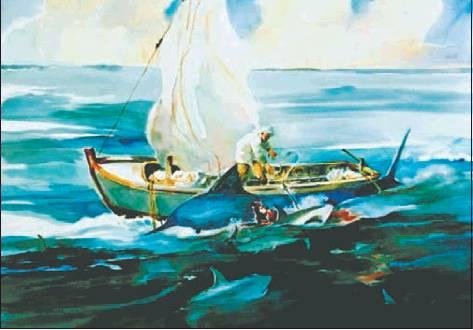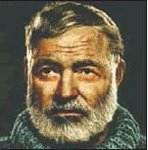A classic adventure bears life lessons
Once a month, local authors and writers will recommend to you their favorite books and favorite writers. They will share with you why they love these books and why you, too, may come to love them.
Chronicle Editor Emeritus Jerry Bellune recommends you read Ernest Hemingway’s most memorable book, “The Old Man and the Sea,” a tale worthy of a place on the shelf with the Iliad and the …
This item is available in full to subscribers.
Subscribe to continue reading. Already a subscriber? Sign in
Get 50% of all subscriptions for a limited time. Subscribe today.
Please log in to continueNeed an account?
|
A classic adventure bears life lessons
Once a month, local authors and writers will recommend to you their favorite books and favorite writers. They will share with you why they love these books and why you, too, may come to love them.
Chronicle Editor Emeritus Jerry Bellune recommends you read Ernest Hemingway’s most memorable book, “The Old Man and the Sea,” a tale worthy of a place on the shelf with the Iliad and the Odyssey by Homer.
Among the masterpieces of American literature stands this wee book of only 27,000 words.
It’s less than 60 pages and can be read in an afternoon.
It won the Pulitzer Prize and led to the Nobel Prize.
I’ve read “The Old Man and the Sea” 3 times.
Our school librarian gave it to me years ago. She knew I wanted to be a writer.
I read it again when we visited Hemingway’s home on Key West. By then I was a husband, father and full-time newspaper editor. It revealed new lessons.
My 3rd time was preparing for a Shepherds Center course on great books, and it gave up even more lessons.
On the surface, Hemingway’s story seems simple. It isn’t. It is filled with such complex concepts as success, failure, hunger, nobility of character, understanding and respecting nature, fate, pride and being a man.
It is based in part on a true story, as is most literature.
It took insight and imagination to conjure up an adventure in the Gulf Stream off the Cuban coast.
Hemingway named his hero Santiago, but he was based on a real fisherman, his friend Gregorio Fuentes.
In an essay Hemingway described an “old man fishing alone in a skiff out of Cabañas” who hooked a big marlin that dragged him out to sea for 2 days. The man strapped the fish to his boat and fought off sharks attracted to its blood. What was left of the fish, less than half, weighed 800 pounds.
Like Santiago, Fuentes was gaunt and thin, had blue eyes, came from the Canary Islands and captained Hemingway’s boat. The two often talked about the novel he was writing.
Life lessons
At the heart of the story is Santiago and the boy Manolin who admires, loves and steals food for him although his family has forbidden him to have anything to do with the old man who everyone considers unlucky.
Despite his struggle with fate, he works hard, maintains inner dignity without complaint nor surrender.
This is a continuing theme in Hemingway’s work. A man must rise above his circumstances, no matter what. It is how to win in life.
Santiago has not caught a fish in 84 days. On the 85th day he goes far out into the Gulf stream and hooks a giant Atlantic marlin. He battles the marlin for 3 days, talking to the fish he comes to admire and love for its determination to get away.
“Then the fish came alive, with his death in him, and rose high out of the water showing all his great length and width and all his power and his beauty,” Hemingway wrote. “He seemed to hang in the air above the old man in the skiff. Then he fell into the water with a crash that sent spray over the old man and over all of the skiff.”
Both exhausted, Santiago pulls the fish to his boat and kills it with a harpoon.
As the fish is too large for his boat, he ties it to the side and heads home. But the marlin’s blood attracts sharks. Santiago kills one with his harpoon but loses the weapon in the battle.
Other sharks attack again and again, and Santiago cannot fight them off.
Eventually, the sharks leave little of the magnificent fish but its bones.
Never accept defeat
This reveals another of Hemingway’s favorite themes – to never give up.
A man can be destroyed but never defeated.
Hemingway is saying to live your life to your fullest potential, never give in, never surrender, as he has tried to show in his own life.
In many of his books and stories central characters die but leave a legacy.
The British nurse Catherine Barkley dies at the end of “A Farewell to Arms.”
The American Robert Jordan gives up his life to stop the enemy advance in “For Whom the Bell Tolls.”
Hemingway believed that our lives may be ended, but our example lives on, and it will inspire others.
Santiago has only an old boat and body. But he inspires the boy to see that you must never quit trying. He knows that if he keeps trying, he will ultimately win.
Although sharks destroy his marlin, he brings home the evidence in the big fish’s skeleton lashed to his boat.
In life, all of us face challenges. Welcome them because they will test you and help you grow stronger, smarter and resilient.
Santiago’s marlin mirrors Santiago’s spirit and determination to succeed.
Before the fish collapses from his 3-day struggle against the man, it comes alive for one final surge, just like the old man near the end of his own life giving it one final surge.
Santiago sails home without his fish, but he returns with a renewed reputation.
Hemingway often put himself in harm’s way. He admired warriors, bull fighters and others who regularly faced danger. He felt most alive when facing death.
How we react to danger says a lot about our character. It’s in struggle that we achieve our potential.
As Santiago sails home, he knows the sharks may destroy his marlin. And he fears he may not be strong enough to defend it.
But when they come, he fights and kills a few.
His lesson: We are never too old to put up a fight.
Another lesson
As a big game hunter as well as fisherman, Hemingway had a great respect for nature and wild animals.
“The fish is my friend too,” Santiago thinks. “He was sorry for the great fish.”
Santiago is torn between landing such a beautiful creature and a need to survive. He respects the marlin.
In the end, the marlin is only bones, but Santiago is not defeated. He had never stopped fighting.
Other items that may interest you












Comments
No comments on this item Please log in to comment by clicking here